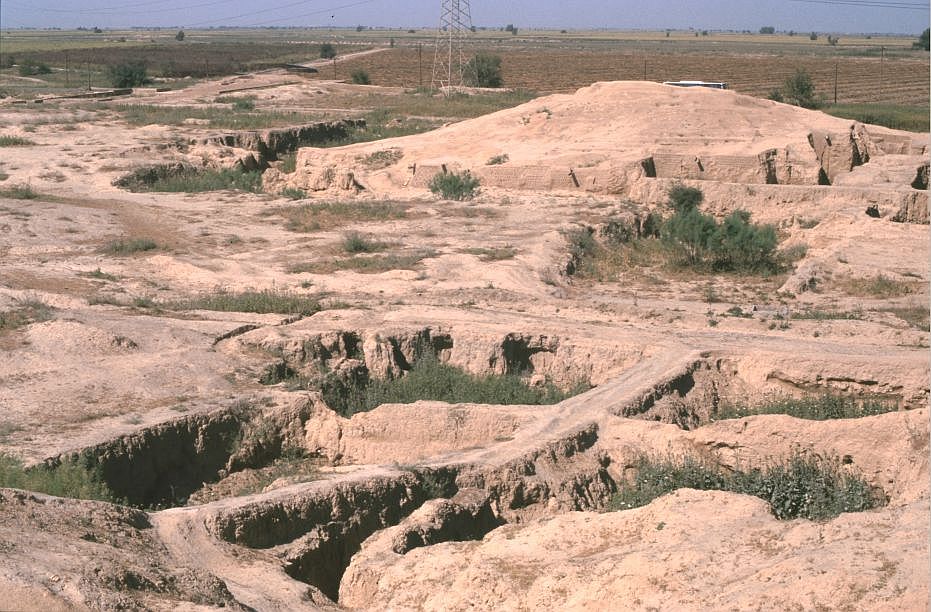Haft Tepe
The name Haft Tepe means Seven Mounds , although in fact the site covers more than a dozen mounds including several massive ziggurats , probably originally 25 m. high , royal graves , temples and palaces.
During the first season a late fourth and early third millennium B.C. wall was uncovered , together with rough, coarse pottery that possibly dates from the sixth millennium.
Painted ware contemporary with Ja farabad , a site near Susa , was followed by ware similar to that of the lowest Susa levels , and this again by proto-literate Elamite and finally , characteristic second millennium B.C.Elamite pottery.
The discovery of the Haft Tepe site has filled one of the less well-documented periods in Elamite history, between c. 1500 B.C. and 1300 B.C.- just before the most illustrious period of the Elmite Empire , the thirteenth century B.C. which saw the construction of the impressive ziggurat of Chogha Zanbil. This was probably the city of Tikni.
Begin with the structures by the side of the main road , at the northern edge of the area , which was first revealed when work began on the road for the sugar factory.
Here you will see two tombs with vaulted roofs. The larger , eastern chamber , 10.30×3.25 m. in size and known as the Royal Tomb , contained twenty-one skeletons.
A platform 60 cm. high covers four-fifths of the rear.
The platform was divided into three sections by low narrow walls pierced with holes to allow drainage into the channel.
Seven skeletons were lying side by side , all packed in ritual red ochre , with a few funerary object in the first section.
The smallest , and middle , section was empty , but at the back werw two incomplete skeletons.
A doorway behind the platforms led up a flight of stairs into the temple behind , which can be seen after climing the ramp to the top of the mound.
Never this doorway twelve roughly heaped , incomplete skeletons were found.
This is a particulary important tomb because it still retains one of the earliest known vaults, dated about 1500 B.C., that is, some 250-300 years older than similar arches at Chogha Zanbil.

Early morning light is best for photographing this tomb.
The second, smaller tomb lies parallel to and a litter to the west of the Royal Tomb. Walk up the ramp by the side of the latter, turn right and you can look down on the open grave whose roof has disappeared but which has been given a temporary protective covering.
Here fourteen skeletons can still be seen laid side by side like sardines, with nine others thrown carelessly on top of them.
In other rooms around the large temple behind the tombs, simple burials in the earth or in urns were found as well as a sarcophagus of backed clay bound with ropes and coated with bitumen.
Below the paved brick floor of the hall behind the Royal Tomb there appears to be another as yet unexcavated room.
A large portico leads off the hall, opening onto the brick-paved temple courtyards in the centre of which is a deep pit, dug by treasure hunters. Built of nine layers of backed brick, this was originally an altar; close by were found many fragments of inscribed stelae, one large portion still lying in situ, probably part of two major inscriptions which list the allowances of grain and animals to be given the priests in payment for services at the temple.
Written in Babylonian cuneiform script using fourteenth century B.C. Elamite language, the inscriptions mention the name of King Tepti-ahar, possibly the ruler of a break-away group from the main Elamite centre at susa, where a brick bearing his name was found. Differing religious beliefs may have included human sacrifice.
Between the temples and the Museum is a series of huge courtyards, many with columns of earth supporting Sassanian skeletons found near the surface and left as evidence of prolonged occupation. In the Elamite level,kitchens and wells lie outside palace buildings whose walls were painted with yellow, red , black and white plaster. Here some 4,000 inscribed clay tablets, mainly accounts and treaties, were found , although some were obviously used for teaching, the mistakes pressed out of shape or preserved inside the clay.
A massive wall surrounds the palace area, while outside, an industrial section includes two kilns for ceramics and metal, and a nearly well where the royal portrait busts and an elephant skull with tusks that had been partly carved for decorative use, were recovered.
Other finds have included a bronze plaque, possibly part of a door frame showing a warrior-king standing on a lion and holding a bow, with a quiver at his back, behind
Him stands a priest while a nude woman kneels before him. The workmanship is characteristic of the mid-second millennium and has been compared with a figurine of the fertility goddess Ishtar found some years ago on the same site.(See short reports in Iran,v,1967,and VII,1969.)
The work at Half Tepe was carried out in co-operation with the Institute of Archaeology of the University of Tehran.
